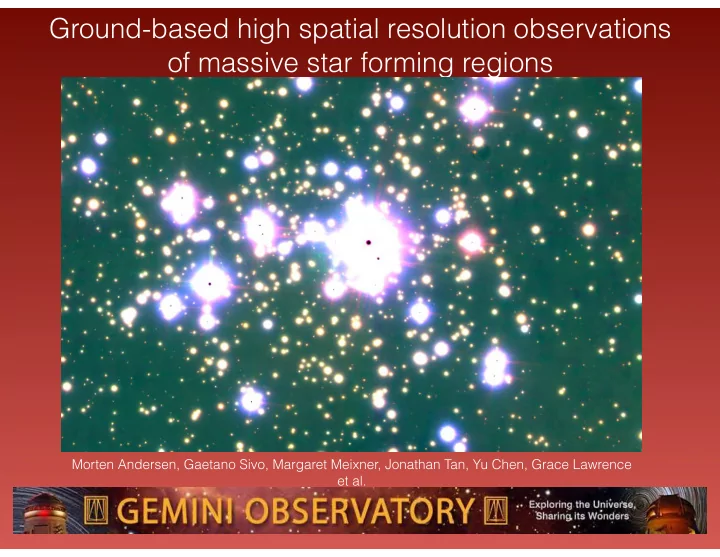

Ground-based high spatial resolution observations of massive star forming regions Morten Andersen, Gaetano Sivo, Margaret Meixner, Jonathan Tan, Yu Chen, Grace Lawrence et al.
How massive star clusters are formed is poorly known • What is their low-mass IMF? • Is their formation fast or slow? (relative to the ff time) • High spatial resolution is key to reach low masses • Proper motion to probe the dynamics of the clusters
How is the IMF assembled? Westerlund 1, Andersen et al. 2017a
JWST+NIRCAM will be revolutionary • >10^4 objects within a few arc minutes • High contrast, from O stars to brown dwarves • Accurate photometry to derive e.g. disk fractions • High sensitivity to reach the lowest mass objects • Relatively large field-of-view
MCAO can do high spatial resolution • 8 meter class telescopes can achieve ~60-70mas • 1.5-2 arc minute field of view • Stable PSF across the field of view • Increases the probability of suitable guide stars • Can do larger surveys, more time epochs etc.
GeMS+GSAOI • 5 laser spot MCAO system, 85” FOV • ~30% Strehl in the K band • 70 mas or better spatial resolution in the K band • Up to 3 NGS, can work with 1 or more
Wd 1 • Most massive young star cluster in Galaxy • 3-5 Myr, distance of 3-5 kpc. • ~50 000 Msun total mass
FOV of GSAOI within Wd1
NGS configuration on the observed mosaic
GSAOI (2.1 micron) vs HST (F125W) FOV 45”x60”
Source detection: GSAOI (left), HST (right) Increased source counts mainly due to resolution
G286, forming massive star cluster • HCO+ line analysis suggest infall of 0.03 Msun/yr • Total mass uncertain, at least 2000 Msun (dust) • Could be up to 10^4 Msun (line data) • Few red sources identified in shallow observations
Andersen et al. 2017, ApJ
Andersen et al. 2019, in Prep
Three main regions identified
Large differences in extinction
Large disk fractions Disk fractions 27-44% (small fraction in control field)
A competitor to 30 Dor? Ochsendorf et al. 2017
A competitor to R136? Ochsendorf et al. 2017
N79 1’, 15 pc N79, GS FLAMINGOS 2 JHK Andersen et al. in prep
N79 Andersen et al. in prep
N79 Andersen et al. in prep
N79 Andersen et al. in prep
Improved MCAO: GNAO • a GeMS system for Gemini North • 2’ Field of view. • 0.8-2.4micron throughput • 50% Strehl in K band at 45 degrees across the field
GNAO performance
Next step: GNAO • Particular attention to astrometric precision • Aiming for 0.2 mas • 0.8-2.4micron throughput • 50% Strehl in K band at 45 degrees across the field
Next step: GNAO • Much more nimble operation than GeMS • Part of queue observing, well suited for ToOs • 15 minute or faster acquisition • Capable of non-sidereal tracking
Next step: GNAO • CoDR in one month (exactly) • PDR end of next August • First light in 2024 • First light instrument : GNAOI imager • GIRMOS (5 arm IFU) is anticipated to go to GN
Recommend
More recommend